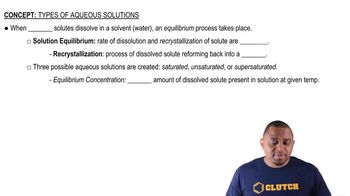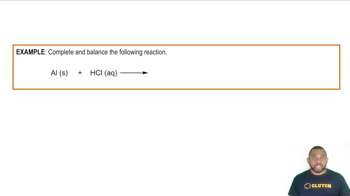Iron corrodes to produce rust, Fe2O3, but other corrosion products that can form are Fe(O)(OH), iron oxyhydroxide, and magnetite, Fe3O4. (a) What is the oxidation number of Fe in iron oxyhydroxide, assuming oxygen's oxidation number is -2? (b) The oxidation number for Fe in magnetite was controversial for a long time. If we assume that oxygen’s oxidation number is - 2, and Fe has a unique oxidation number, what is the oxidation number for Fe in magnetite? (O)(OH), iron oxyhydroxide, and magnetite, Fe3O4. (c) It turns out that there are two different kinds of Fe in magnetite that have different oxidation numbers. Suggest what these oxidation numbers are and what their relative stoichiometry must be, assuming oxygen’s oxidation number is -2.
Ch.20 - Electrochemistry

Brown15th EditionChemistry: The Central ScienceISBN: 9780137542970Not the one you use?Change textbook
Chapter 20, Problem 93d
(d) Why is sodium metal not obtained when an aqueous solution of NaCl undergoes electrolysis?
 Verified step by step guidance
Verified step by step guidance1
Understand the process of electrolysis: Electrolysis involves passing an electric current through a solution to cause a chemical change. In the case of NaCl, the solution is aqueous, meaning water is present.
Identify the ions present in the solution: In an aqueous NaCl solution, the ions present are Na⁺, Cl⁻, H⁺ (from water), and OH⁻ (from water).
Determine the possible reactions at the cathode: At the cathode, reduction occurs. The possible reductions are Na⁺ + e⁻ → Na (sodium metal) and 2H₂O + 2e⁻ → H₂ + 2OH⁻ (hydrogen gas).
Compare the reduction potentials: The reduction potential for Na⁺ to Na is more negative than that for water to hydrogen gas. This means that water is more easily reduced than Na⁺ in an aqueous solution.
Conclude why sodium metal is not obtained: Since water is reduced preferentially over Na⁺, hydrogen gas is produced at the cathode instead of sodium metal during the electrolysis of aqueous NaCl.

Verified video answer for a similar problem:
This video solution was recommended by our tutors as helpful for the problem above.
Video duration:
1mWas this helpful?
Key Concepts
Here are the essential concepts you must grasp in order to answer the question correctly.
Electrolysis
Electrolysis is a chemical process that uses electrical energy to drive a non-spontaneous reaction. In the context of aqueous solutions, it involves the decomposition of compounds into their constituent elements or ions when an electric current is passed through the solution. The process occurs at electrodes, where oxidation and reduction reactions take place, leading to the formation of different products depending on the ions present.
Recommended video:
Guided course

The Electrolytic Cell
Ionic Compounds in Aqueous Solution
When ionic compounds like NaCl dissolve in water, they dissociate into their respective ions, Na⁺ and Cl⁻. In an aqueous solution, water molecules also participate in the electrolysis process, which can lead to the production of hydrogen gas at the cathode and oxygen gas at the anode. The presence of water and its competing reactions significantly influences the products formed during electrolysis.
Recommended video:
Guided course

Types of Aqueous Solutions
Electrode Reactions and Product Formation
During electrolysis, the reactions that occur at the electrodes depend on the relative reactivity of the ions present. In the case of NaCl electrolysis, water is more easily reduced than sodium ions, leading to the production of hydrogen gas instead of sodium metal. Similarly, at the anode, chloride ions are oxidized to form chlorine gas, rather than oxidizing water to produce oxygen, which further explains why sodium metal is not obtained.
Recommended video:
Guided course

Production of Hydrogen Example
Related Practice
Textbook Question
Textbook Question
Copper corrodes to cuprous oxide, Cu2O, or cupric oxide, CuO, depending on environmental conditions. (a) What is the oxidation state of copper in cuprous oxide?
Textbook Question
(c) What process occurs at the anode in the electrolysis of molten NaCl?
Textbook Question
(d) Why are active metals such as Al obtained by electrolysis using molten salts rather than aqueous solutions?
Textbook Question
(a) A Cr3+(aq) solution is electrolyzed, using a current of 7.60 A. What mass of Cr(s) is plated out after 2.00 days?
Textbook Question
(b) What amperage is required to plate out 0.250 mol Cr from a Cr3+ solution in a period of 8.00 h?
